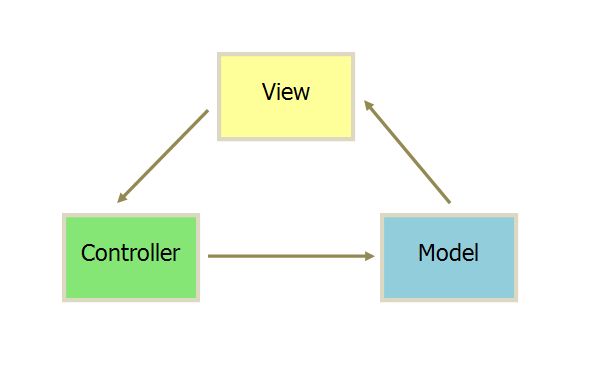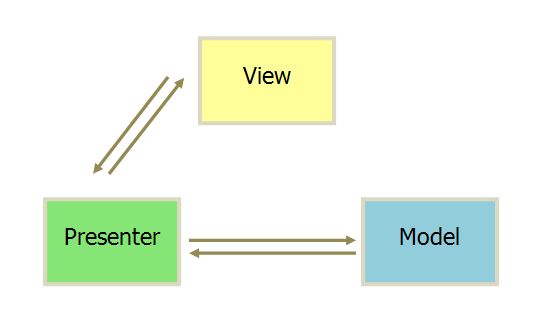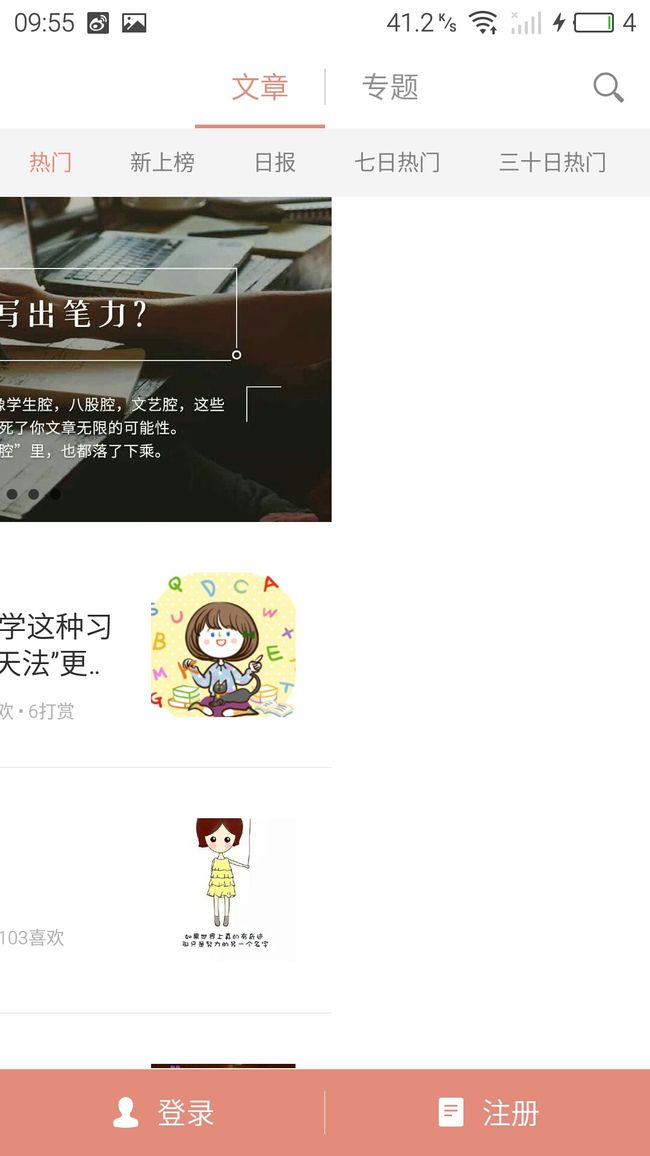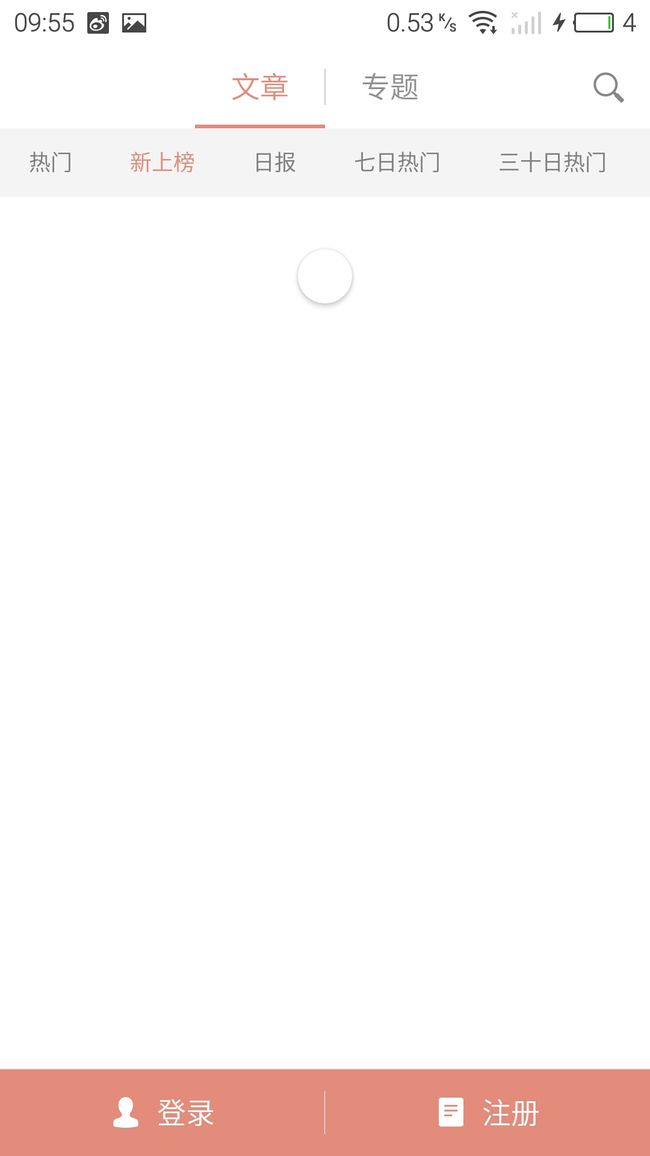演示效果:
这里的演示效果是利用TabLayout+ViewPager+Fragment完成的,由于本篇文章不是讲具体实现,所以和MVP思想不相关的具体实现代码我会忽略一部分。
前言
MVP开发模式,算是老生常谈的话题了,最近一段时间也比较热门,网上相关的资料不少,这里就不再做重复的描述。
这里谈一下个人的一些理解:
由于Android平台的特殊性,从MVC的角度来讲,XML布局文件作为视图层(V),Activity作为控制层(C),一些具体的业务操作,如读写数据库,网络访问等作为业务逻辑层(M),单纯的XML布局又不能满足V层的需要,例如我们需要对一个控件进行动态的隐藏和显示,这点单纯的XML是办不到的,此时我们只能在Activity里去做实现了,这样子下来,使得Activity既是V又是C,随着业务的扩展,代码逻辑也渐渐变得复杂起来,加上MVC模式的设计,Model层和View层又是直接交互的,导致Activity的职责会变得很重,慢慢的变得臃肿不堪,不易扩展,更不要提测试了。
既然有问题的存在,自然就有解决问题的办法,此时MVP出现了,在我看来MVP模式其实就是从并不标准的MVC模式演化而来的,它减轻了Activity的职责,简化了Activity的代码,把复杂的逻辑交给了P层来处理,较低了系统的耦合度,更加方便了测试。
这样的开发模式下来,也使得各层的职责更加单一了,V层只关心用户的输入请求动作,P层相当于V层和M层的“信使”只关心转发数据,来自V层的请求数据,来自M层的响应数据,而M层则只需要关心的具体的业务逻辑操作即可。
言归正传
说了这么多,来点实战吧,这里我演示一个比较常见的功能,列表的下拉刷新和上拉加载数据。
所涉及的开源框架:
网络加载框架:Retrofit
图片加载框架:Picasso
响应式编程框架:Rxjava
注解框架:ButterKnife
带有下拉刷新,上拉加载的RecyclerView:XRecyclerView
JSON数据的解析:Gson
数据来源
http://gank.io/api/data/%E7%A6%8F%E5%88%A9/10/1
这里的来源是来自GANK.IO的福利妹纸图,然后利用GsonFormat生成JavaBean,代码太长我就不贴了。
关于基类
View层
/** * 基类View接口
* Created by chenwei.li
* Date: 2016-01-11
* Time: 00:22
*/
public interface IBaseView {
void showLoadingDialog();
void cancelLoadingDialog();
void showErrorMsg(String errorMsg);
}
这个基础View接口需要让每个具体的业务View都去继承实现,里面封装了一些常用的方法,例如我们在加载数据的时候都为了良好的用户体验,都需要显示进度条,或者弹出对话框来提醒用户正在进行,当数据加载完毕都需要关闭这个提醒,当加载出错的时候,需要提醒用户出错信息。
/**
* 基类Fragment
* Created by chenwei.li
* Date: 2016-01-03
* Time: 23:52
*/
public abstract class BaseFragment extends Fragment implements IBaseFragment {
//当前Fragment视图对象
protected View mView;
/**
* Activity对象,避免getActivity()出现null
*/
protected Activity mActivity;
@Override
public void onAttach(Context context) {
super.onAttach(context);
this.mActivity = (Activity) context;
}
@Nullable
@Override
public View onCreateView(LayoutInflater inflater, ViewGroup container, Bundle savedInstanceState) {
/**
* 绑定视图
*/
if (mView == null) {
mView = inflater.inflate(bindLayout(), container, false);
}
/**
* 依赖注入
*/
ButterKnife.bind(this, mView);
/**
* 创建Fragment
*/
createFragment(savedInstanceState);
/**
* 初始化视图,默认值
*/
initView();
/**
* 获取对应数据(网络,数据库)
*/
getData();
return mView;
}
@Override
public void onDestroy() {
super.onDestroy();
/**
* 解绑ButterKnife
*/
ButterKnife.unbind(this);
}
}
/**
* 基类Fragment(懒加载)
* Create by: chenwei.li
* Date: 2016-05-26
* time: 09:15
* Email: [email protected]
*/
public abstract class BaseLazyFragment extends Fragment implements IBaseFragment {
//当前Fragment视图对象
protected View mView;
/**
* 是否加载布局
*/
protected boolean isPrepare;
/**
* 是否显示布局
*/
protected boolean isVisiable;
/**
* 是否是第一次加载
*/
protected boolean isFirst;
/**
* Activity对象,避免getActivity()出现null
*/
protected Activity mActivity;
@Override
public void onAttach(Context context) {
super.onAttach(context);
this.mActivity = (Activity) context;
}
@Nullable
@Override
public View onCreateView(LayoutInflater inflater, ViewGroup container, Bundle savedInstanceState) {
/**
* 绑定视图
*/
if (mView == null) {
mView = inflater.inflate(bindLayout(), container, false);
isPrepare = true;
isFirst = true;
}
/**
* 依赖注入
*/
ButterKnife.bind(this, mView);
/**
* 创建Fragment
*/
createFragment(savedInstanceState);
/**
* 初始化视图,默认值
*/
initView();
return mView;
}
/**
* 判断当前Fragment是否已经显示
*
* @param isVisibleToUser
*/
@Override
public void setUserVisibleHint(boolean isVisibleToUser) {
super.setUserVisibleHint(isVisibleToUser);
if (getUserVisibleHint()) {
isVisiable = true;
onVisible();
} else {
isVisiable = false;
}
}
protected void onVisible() {
lazy();
}
/**
* 要进行懒加载的数据
*/
protected void lazy() {
if (isPrepare && isVisiable && isFirst) {
lazyLoadData();
isFirst = false;
}
}
/**
* 需要进行懒加载的数据
*/
protected abstract void lazyLoadData();
/**
* 只需要空实现,所有的懒加载数据都在lazyLoadData里面执行
*/
@Override
public void getData() {
}
}
上面是基础类BaseFragment的封装,实现了IBaseFragment接口里的方法,代码并不复杂,大家根据注释看下就可以理解了,这里因为我的注入框架用的ButterKnife,所以在创建Frgament的时候,我去绑定了View,当Fragment销毁的时候,去取消绑定。
这里根据具体业务,我又多封装了一个具有懒加载功能的Fragment,这个LazyBaseFragment和普通的Fragment区别在于,当我们使用ViewPager去嵌套Fragment的时候,由于ViewPaer的原因,默认它会加载当前页面的左右各一个页卡,有时候用户需要看当前页面并不执行滑动操作去看其他的,但是程序已经加载了页面,势必会造成一些资源浪费,所以我根据setUserVisibleHint(boolean isVisibleToUser)和标志位的判断,来确定在页面加载且用户滑到当前页的时候才去加载数据的。这点的想法起源来自的APP,大家看下图就能明白:
很明显,也运动了Fragment的懒加载,这里可能有朋友会说关于ViewPager里的setOffscreenPageLimit(int pgaeSize)方法,这个方法的作用是控制ViewPager保留当前页面的左右各几个页面的数据状态,而不让它进行滑动销毁,也可以决定ViewPager一次性加载几个页卡,所以把它设置为0不就解决了,其实不是的,如果你用去看过ViewPager的源码,你就会发现这样的一段代码:
/**
* Set the number of pages that should be retained to either side of the
* current page in the view hierarchy in an idle state. Pages beyond this
* limit will be recreated from the adapter when needed.
*
* This is offered as an optimization. If you know in advance the number
* of pages you will need to support or have lazy-loading mechanisms in place
* on your pages, tweaking this setting can have benefits in perceived smoothness
* of paging animations and interaction. If you have a small number of pages (3-4)
* that you can keep active all at once, less time will be spent in layout for
* newly created view subtrees as the user pages back and forth.
*
* You should keep this limit low, especially if your pages have complex layouts.
* This setting defaults to 1.
*
* @param limit How many pages will be kept offscreen in an idle state.
*/
public void setOffscreenPageLimit(int limit) {
if (limit < DEFAULT_OFFSCREEN_PAGES) {
Log.w(TAG, "Requested offscreen page limit " + limit + " too small; defaulting to " +
DEFAULT_OFFSCREEN_PAGES);
limit = DEFAULT_OFFSCREEN_PAGES;
}
if (limit != mOffscreenPageLimit) {
mOffscreenPageLimit = limit;
populate();
}
}
而这里的
private static final int DEFAULT_OFFSCREEN_PAGES = 1;
所以不管你是设置0,或者更小的数,默认它都是为1的,也就是默认加载3个页卡,保留当前页卡的左右页卡状态。
Presenter层
/**
* 基类Presenter接口
* Create by: chenwei.li
* Date: 2016-05-31
* time: 14:25
* Email: [email protected]
*/
public interface IBasePresenter {
/**
* V层注入引用
* @param mvpView
*/
void attachView(V mvpView);
/**
* 销毁V层引用
*/
void detachView();
}
这里封装了2个方法,用来使View层的Activity和Fragment和P层的生命状态保持一致,当页面销毁的时候,这次Context上下文的引用也就没有理由存在了,这里我们把它置为null,便于GC回收。
/**
* 基类BasePresenter
* Create by: chenwei.li
* Date: 2016-05-31
* time: 11:14
* Email: [email protected]
*/
public class BasePresenter implements IBasePresenter {
private T mMvpView;
@Override
public void attachView(T mvpView) {
this.mMvpView = mvpView;
}
@Override
public void detachView() {
this.mMvpView = null;
}
public T getMvpView() {
return mMvpView;
}
}
基类Presenter,让所有的P层继承。
具体代码
View层
/**
* View层妹纸福利
* Create by: chenwei.li
* Date: 2016-05-26
* time: 22:06
* Email: [email protected]
*/
public interface IWealView extends IBaseView {
void getWealList(int pageSize, int currentPage);
void onRefreshData(List resultsBean);
void onLoadMoreData(List resultsBean);
}
这里提供了操作接口,因为在本页面的业务只是单纯的加载列表数据,刷新数据,所以这里定义了3个方法,用来满足业务。
/**
* 福利Fragment
* Create by: chenwei.li
* Date: 2016-05-25
* time: 11:19
* Email: [email protected]
*/
public class WealFragment extends BaseLazyFragment implements IWealView {
@Bind(R.id.rv_wealView)
XRecyclerView mRvWealView;
//福利适配器与数据源
private WealAdapter mWealAdapter;
private List mResultsBeans;
//福利P层
private WealPresenter mWealPresenter;
//记录当前页数,默认为1
private int mCurrentPage = 1;
/**
* 懒加载数据
*/
@Override
protected void lazyLoadData() {
getWealList(10, mCurrentPage);
}
@Override
public int bindLayout() {
return R.layout.fragment_weal;
}
@Override
public void createFragment(Bundle savedInstanceState) {
}
@Override
public void initView() {
//注入P层
mWealPresenter = new WealPresenter();
mWealPresenter.attachView(this);
//创建数据源,设置适配器
mResultsBeans = new ArrayList();
mWealAdapter = new WealAdapter(mResultsBeans);
mRvWealView.setLayoutManager(new StaggeredGridLayoutManager(2, StaggeredGridLayoutManager.VERTICAL));
mRvWealView.setAdapter(mWealAdapter);
//设置动画,刷新样式
mRvWealView.setItemAnimator(new DefaultItemAnimator());
mRvWealView.setArrowImageView(R.drawable.iconfont_downgrey);
//监听刷新数据
mRvWealView.setLoadingListener(new XRecyclerView.LoadingListener() {
@Override
public void onRefresh() {
mCurrentPage = 1;
getWealList(10, mCurrentPage);
}
@Override
public void onLoadMore() {
getWealList(10, mCurrentPage);
}
});
}
@Override
public void showLoadingDialog() {
}
@Override
public void cancelLoadingDialog() {
}
/**
* 显示错误信息
*
* @param errorMsg
*/
@Override
public void showErrorMsg(String errorMsg) {
ToastUtil.showShort(MyApplication.getContext(), errorMsg);
}
/**
* 获取数据
*
* @param pageSize
* @param currentPage
*/
@Override
public void getWealList(int pageSize, int currentPage) {
mWealPresenter.getWealList(pageSize, currentPage);
mCurrentPage++;
}
/**
* 下拉刷新数据回调
* @param resultsBean
*/
@Override
public void onRefreshData(List resultsBean) {
mResultsBeans.clear();
mResultsBeans.addAll(resultsBean);
mWealAdapter.notifyDataSetChanged();
mRvWealView.refreshComplete();
}
/**
* 上拉加载数据回调
* @param resultsBean
*/
@Override
public void onLoadMoreData(List resultsBean) {
mResultsBeans.addAll(resultsBean);
mWealAdapter.notifyDataSetChanged();
mRvWealView.loadMoreComplete();
if (resultsBean.size() < 10) {
//当加载新数据的条数不足10条,则关闭上拉加载
mRvWealView.setLoadingMoreEnabled(false);
}
}
@Override
public void onDestroy() {
super.onDestroy();
mWealPresenter.detachView();
}
}
这里采用了懒加载LazyFragment,当页面加载完毕且用户当前界面处于它的时候,会调用执行lazyData加载数据,当下拉刷新,上拉加载的时候会对应的执行方法,且改变当前页码。这里在页面初始化加载和销毁的时候,分别去调用了P层的注入和销毁方法,用来保存生命状态一致。
Presenter层
/**
* 获取福利Presenter层
* Create by: chenwei.li
* Date: 2016-05-26
* time: 22:20
* Email: [email protected]
*/
public class WealPresenter extends BasePresenter {
private IWealModel iWealModel = new WealModel();
@Override
public void attachView(IWealView mvpView) {
super.attachView(mvpView);
}
@Override
public void detachView() {
super.detachView();
}
/**
* 根据加载数量和页码加载数据
*
* @param pageSize
* @param currentPage
*/
public void getWealList(int pageSize, final int currentPage) {
iWealModel.getWealList(pageSize, currentPage, new Subscriber() {
@Override
public void onCompleted() {
}
@Override
public void onError(Throwable e) {
getMvpView().showErrorMsg(e.getMessage());
}
@Override
public void onNext(WealEntity wealEntity) {
if (wealEntity.getResults() != null) {
if (currentPage == 1) {
getMvpView().onRefreshData(wealEntity.getResults());
} else {
getMvpView().onLoadMoreData(wealEntity.getResults());
}
}
}
});
}
}
这里没什么好说的,只是作为“信使”,传递了View层的请求给Model层,并通过Rxjava的订阅回调对应的方法,再次传递数据给View层。
Model层
/**
* 网络接口包装类
* Create by: chenwei.li
* Date: 2016-05-23
* time: 00:43
* Email: [email protected]
*/
public class RetrofitWapper {
private static RetrofitWapper mRetrofitWapper;
private Retrofit mRetrofit;
/**
* 将构造函数私有化
*/
private RetrofitWapper() {
mRetrofit = new Retrofit.Builder().baseUrl(Constant.BASE_URL).addConverterFactory(GsonConverterFactory.create()).addCallAdapterFactory(RxJavaCallAdapterFactory.create()).build();
}
/**
* 获取RetrofitWapper实例(单例模式)
*
* @return
*/
public static RetrofitWapper getRetrofitWapperInstance() {
if (mRetrofitWapper == null) {
synchronized (RetrofitWapper.class) {
mRetrofitWapper = new RetrofitWapper();
}
}
return mRetrofitWapper;
}
/**
* 创建接口访问入口
* @param service
* @param
* @return
*/
public T create(Class service) {
return mRetrofit.create(service);
}
public class Constant {
public static final String BASE_URL = "http://gank.io/api/";
}
}
这里写了一个帮助类,用来提供Retrofit的实例(单例),由于Retrofit底层默认是提供Okhttp支持的,所以如果这里要对Okhttp进行个性化定制也是很容易的,例如:
private RetrofitWapper() {
OkHttpClient.Builder okHttpClient = new OkHttpClient.Builder();
okHttpClient.connectTimeout(5, TimeUnit.SECONDS);
mRetrofit = new Retrofit.Builder().client(okHttpClient.build()).baseUrl(Constant.BASE_URL).addConverterFactory(GsonConverterFactory.create()).addCallAdapterFactory(RxJavaCallAdapterFactory.create()).build();
}
再来看下Retrofit的service:
/**
* Gank.io接口类
* Create by: chenwei.li
* Date: 2016-05-26
* time: 16:11
* Email: [email protected]
*/
public interface GankApiService {
/**
* 获取福利列表
*
* @param pageSize
* @param currentPage
* @return
*/
@GET("data/福利/{pageSize}/{currentPage}")
Observable getWealList(@Path("pageSize") int pageSize, @Path("currentPage") int currentPage);
}
Model层的业务接口及实现:
/**
* 获取福利Model层接口
* Create by: chenwei.li
* Date: 2016-05-26
* time: 22:31
* Email: [email protected]
*/
public interface IWealModel {
void getWealList(int pageSize,int currentSize, Subscriber wealEntitySubscriber);
}
/**
* Create by: chenwei.li
* Date: 2016-05-26
* time: 22:28
* Email: [email protected]
*/
public class WealModel implements IWealModel {
private GankApiService mGankApiService;
/**
* 获取福利列表数据
*
* @param pageSize
* @param currentSize
* @param wealEntitySubscriber
*/
@Override
public void getWealList(int pageSize, int currentSize, Subscriber wealEntitySubscriber) {
mGankApiService = RetrofitWapper.getRetrofitWapperInstance().create(GankApiService.class);
mGankApiService.getWealList(pageSize, currentSize).subscribeOn(Schedulers.io()).observeOn(AndroidSchedulers.mainThread()).subscribe(wealEntitySubscriber);
}
}
这里的代码很简单,就不再做过多的文字描述了,对于Rxjava和Retrofit不熟悉的朋友可以网上查看下相关资料。
最后
关于软件开发设计模式,其实并没有最好的选择,只有更适合的选择,很多时候我们抛开业务去谈设计,架构都是飘渺的,我认为开发还是需要灵活点,不应该被某模式某架构所束缚,这样变得好像是为了目的而目的,已经脱离了设计模式最初的设计意义。
比如这个MVP,对于业务很简单的小型APP来说,有时候明明只需要几个类就可以解决的事情,非要使用MVP,会使其多了一大堆接口,导致开发成本变大,但也不是全然无用,至少它的代码层次清晰了。



